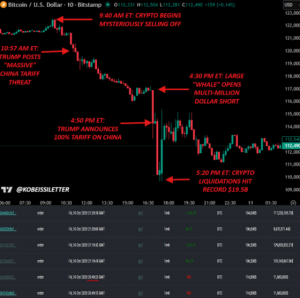The $20 Billion Crypto Meltdown: How Geopolitics and Leverage Broke the Crypto Market
Ethan DiGiacomo
Staff Writer
On Friday, October 10, the crypto market had its largest single-day liquidation event ever, bigger than FTX, COVID, or Luna. Almost $20 billion was wiped out, and 1.6 million traders got liquidated. Over 1,000 traders lost over $100,000, 200 lost more than $1 million, and 358 lost everything. At one point, excluding the top 10 cryptos like Bitcoin and Ethereum, the rest of crypto was down 45% in a matter of 15 minutes. Some cryptos were down 56%. Bitcoin liquidated $5.3 billion and Ethereum $4.4 billion over a 24-hour period. Amid the liquidation, Bitcoin recorded a $20,000 daily candlestick. This marks a $380 billion swing in Bitcoin’s market cap alone in a single day. That’s more than the market cap of all but 25 public companies in the world. So how did this happen, and is this a sign for crypto’s future?
What Caused It
Earlier that week, Bitcoin remained bullish as it had for the past couple of months, and it was reaching all-time highs of over $126,000. By Friday morning, it was still trading at $122,000. Geopolitically, things were a lot less optimistic. The previous day, China had announced export controls on rare earth minerals and permanent magnet exports. Under the new measures, foreign firms will now be required to obtain Chinese government approval to export magnets that contain even trace amounts of Chinese-origin rare earth materials or that were produced using Chinese mining, processing, or magnet-making technologies. The new licensing framework will apply to foreign-produced rare earth magnets and select semiconductor materials that contain at least 0.1 percent heavy rare earth elements sourced from China. This has massive repercussions, as China globally controls 70% of rare earth mining, 90% of separation and processing, and 93% of magnet manufacturing. This particularly affects the U.S. defense industry, as most of the technology, including F-35 jets, Tomahawk missiles, and smart bombs, all use these rare earths. On Friday morning, Trump fired back by announcing on Truth Social “a massive increase in tariffs on Chinese goods.” The markets negatively reacted. Bitcoin dipped from $122,000 to $117,000. Later that afternoon, Trump announced on Truth Social that the U.S. would be imposing a 100% tariff on all Chinese imports. Bitcoin fell immediately, dropping another $3,000. It eventually fell to $104,000. On some exchanges, it even reached $102,000. In just a couple of hours, the world’s largest cryptocurrency dropped by $20,000. Altcoins did not fare any better. Ethereum plunged 21% from its highs, while majors like XRP, Solana, and Dogecoin crashed between 20% and 30%. Others, like Cardano, Chainlink, and Ave, fell as much as 40%.

Why Was the Liquidation So Severe
The liquidation event was the accumulation of extreme leverage, very poor timing, and failing infrastructure. For weeks, leverage had been building up to insane levels. Just before the crash, Bitcoin open interest had surged to a record high of over $94 billion. Looking at the breakdown of liquidations, it was heavily skewed towards longs. Over $16.7 billion in longs were liquidated compared to less than $2.5 billion in shorts. That’s a 6.7:1 ratio. Trump’s announcement only toppled this house of cards. The announcement also hit on a Friday afternoon, a period of low liquidity when traditional markets are closing. This created a domino effect. As the price fell, leveraged long positions were automatically sold by exchanges. These massive sell orders push the price down further, triggering even more liquidations in a vicious downward spiral. In total, a staggering $19.1 billion in leverage positions was wiped out in just 24 hours. Now, to put that into some perspective, the infamous COVID crash of March 2020 saw just $1.2 billion in liquidation. The FTX collapse triggered around $1.6 billion. So, this event was nearly 20 times larger than the COVID panic, and it impacted over 1.6 million individual traders. The carnage was amplified by the very exchanges meant to provide stability. High-profile traders reported that major platforms like Binance, Coinbase, and Robinhood experienced technical issues with order books freezing and stop-loss functions being disabled at the most critical moments. So, this technical failure turned a sharp correction into a complete market collapse.
Insider Trading or Coincidence?
While it may seem like the crypto market is the latest casualty in the ongoing Trump-China trade war, there is some evidence to suggest possible insider trading. On the derivatives exchange Hyperliquid, one whale wallet executed a series of perfectly timed trades that netted them a reported profit of nearly $200 million. This person, known as “HyperWhale”, about 24 hours before the crash, placed shorts against the crypto market. Short is a bet against an underlying asset; if the price of that asset goes down, money is made based on that bet. On October 9th, against Bitcoin, they place an $80 million short; against Ethereum, they place a $30 million short. About 12 hours later, Trump announced that he would create a tariff plan against China. Nobody knew about this announcement, except for possibly the person who made these shorts. This is when the market dips, but the person does not close out the shorts. Not only are they not closed out, but the person also adds onto the shorts. In fact, he places these bets until 3:49 PM EST. One minute later, at 3:50 PM EST, Trump announces 100% tariffs on China, and the market collapses. The shops are only closed for about half an hour after this major announcement. In total, this person made $190 million.

What’s Next for Crypto
Despite the massive loss, Bitcoin held at the $100,000 support zone. This means the flash crash was a derivative-led leverage flush, not a fundamental breakdown in market conviction. In fact, institutions saw this as a time to “buy the dip.” BlackRock’s spot ETF reportedly bought over 21,000 BTC in the midst of the crash. XRP whales added over a billion tokens to their wallets during the dip. This suggests that many still believe the long-term bull run is alive. The fundamentals have not changed. Only sentiment and leverage have. This event has brutally reset the market, clearing out excessive greed and creating a much healthier foundation for a more sustainable climb. The future for altcoins is a lot less clear. Many now wonder if altcoin season is over before it even began. Altcoin season is when altcoins see significant growth and outperform Bitcoin. After the flash crash, the altcoin season index fell to 55, well below the 75-point threshold that signifies a true altcoin season. Bitcoin dominance has spiked as capital has fled to the relative safety of the most popular cryptocurrency. This doesn’t mean altcoins can’t recover, but it does suggest that the days of everything pumping are over. The next alt run will probably be much more selective, driven by specific narratives like AI, real-world assets like gold, or upcoming spot ETF approvals for tokens like Solana and XRP, when the SEC approves ETFs for assets like they just did with Bitcoin. However, the biggest and most unpredictable variable for proper recovery is Trump and his handling of the various geopolitical situations, especially China. Trump has set a November 1st deadline for the tariffs, which gives a couple of weeks of negotiation time. Historically, Trump also often uses extreme threats as a negotiating tactic before later backing down. This has become known as TACO (Trump Always Chickens Out). He could walk back these tariffs in exchange for concessions with China. Investors must now price in the risk that this could be a long, drawn-out conflict. If trade tensions persist, the crypto sell-off could evolve into a broader macro correction. If they ease, we could see a powerful relief rally. The market is now hanging on every tweet, every headline, and every rumor.
Contact Ethan at Ethan.Digiacomo.student@shu.edu

